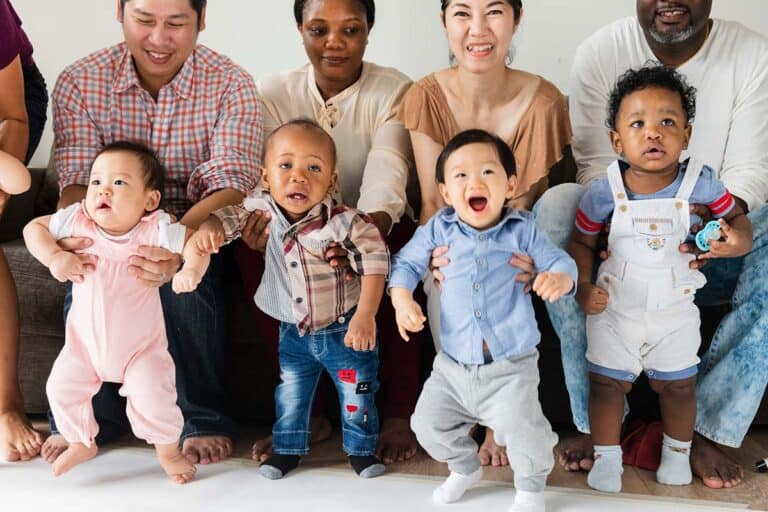In our rapidly changing and wonderfully diverse world, the concept of family has transcended the conventional norms of the past. Families now manifest in a myriad of forms, each unique and deserving of respect and acceptance. It is imperative that we instill in our children not only the ability to recognize this diversity but also the capacity to approach it with an open heart filled with understanding and compassion.
One of the beautiful facets of this evolving landscape of family structures is same-sex parent families. These families, like any other, are built on love, commitment, and the shared goal of nurturing and supporting their children. However, given the diversity of family structures, it becomes increasingly vital to educate our children about the existence of same-sex parent families and to teach them how to appreciate and embrace this diversity with empathy and compassion.
Why It Matters: Fostering Understanding and Compassion:
Understanding and acceptance of diverse family structures are not just commendable values; they are essential life skills that children must develop in today’s increasingly diverse world. Teaching children to embrace same-sex parent families carries profound significance, as it encompasses various facets that play a pivotal role in shaping a child’s worldview. In this section, we will delve deeper into why this matter is so critical and how it can significantly impact a child’s growth and development.
Building Empathy
One of the fundamental reasons why it is vital to educate children about different family structures, including same-sex parent families, is to cultivate empathy within them. By introducing children to diverse family models, we enable them to walk in someone else’s shoes, even if just in their imagination. This exercise in empathy fosters an innate understanding that every family, regardless of its composition, experiences love, joy, and challenges. It helps children recognize that people may have life experiences different from their own and instills in them the ability to relate to and understand others on a deeper level.
From a psychological standpoint, empathy is a critical component of emotional intelligence, enhancing a child’s capacity to form meaningful relationships, resolve conflicts, and navigate the complex social fabric of the world.
Reducing Prejudice
Early education about same-sex parent families holds the potential to significantly reduce prejudice and discrimination later in life. By addressing these topics with children during their formative years, we lay the groundwork for a more inclusive society. Prejudice often stems from fear or ignorance, and providing children with knowledge and understanding acts as a powerful antidote.
When children grow up with an awareness of diverse family structures, they are less likely to develop unfounded biases or stereotypes. They learn to appreciate the beauty of diversity and accept that love transcends boundaries, including those of gender. In essence, early education is a proactive measure against prejudice, fostering an environment of inclusivity where individuals of all backgrounds are respected and valued.
Nurturing Compassion
Compassion is a trait that transcends differences and connects individuals on a profound human level. By educating children about diverse families, we nurture the seed of compassion within them. Compassion allows children to see the humanity in others, irrespective of their family structure, and enables them to offer kindness and support to those who may need it.
This trait not only enhances a child’s ability to build positive relationships but also empowers them to be advocates for fairness and equality. Children who have cultivated compassion are more likely to stand up against discrimination, promote inclusivity, and contribute to creating a harmonious and accepting society.
How to Help Children Understand and Embrace Same-Sex Parent Families
Understanding the significance of teaching children about diverse family structures is the first step. The next step is to equip parents, caregivers, and educators with practical strategies to facilitate this understanding effectively. Here are ten strategies to help children not only understand but also embrace same-sex parent families:
1. Start Early: Begin conversations about diverse families from an early age, as young minds are naturally receptive to new ideas and concepts. Utilize age-appropriate books, TV shows, or movies that feature same-sex parent families to introduce the topic naturally.
2. Honesty and Simplicity: Explain same-sex parent families in simple terms, emphasizing that love is what matters most in a family. Encourage questions and provide honest answers. Children often appreciate straightforward explanations that avoid overcomplicating the topic.
3. Encourage Questions: Children are innately curious, and their questions are a gateway to learning. Encourage them to ask questions about what they see or hear, and respond with patience and sensitivity. These questions are opportunities to provide information and foster understanding.
4. Use Inclusive Language: Model inclusive language by referring to families without making assumptions about parents’ genders. For example, say, “Some families have two moms or two dads.” Avoid gender-specific language when discussing family dynamics.
5. Normalize Differences: Teach children that families come in various forms and that this diversity is what makes the world interesting and beautiful. Highlight the similarities between all families, such as love, care, and the pursuit of happiness.
6. Share Stories: Share stories of same-sex parents and their families, as real-life examples can help children relate and understand better. Reading books, watching movies, or hearing personal stories humanizes the experience of same-sex parent families and makes it relatable.
7. Teach Respect: Emphasize the importance of respecting others’ differences and choices. Discuss how diversity enriches our lives and makes the world a more interesting and colorful place. Encourage kindness and empathy toward everyone, regardless of their family structure.
8. Promote Books and Resources: Ensure your child has access to books and resources that celebrate diversity. Public libraries, schools, and online platforms often have such materials readily available. Encourage your child to explore these resources and learn more about different family structures.
9. Be a Role Model: As a parent or caregiver, set an example of acceptance and understanding. Children are keen observers and tend to emulate the behavior of the adults around them. Show respect for all individuals and families, regardless of their composition, to instill these values in your child.
10. Encourage Friendships: Support your child in making friends from diverse backgrounds. These friendships provide valuable firsthand experiences and help your child develop a broader perspective on the world. Interacting with children from various family structures can be eye-opening and enriching.
In essence, by implementing these strategies, we create an environment where children not only gain knowledge but also internalize values of acceptance, empathy, and compassion. These skills will serve them well as they navigate an increasingly diverse and interconnected world, fostering a society where love, respect, and inclusivity are the cornerstones of human interaction.
The Profound Impact of Early Education
Children, in their early years, are akin to sponges, eagerly absorbing the information and attitudes that surround them. It is during these formative years that the foundation of their beliefs, values, and attitudes is laid. When we consider the importance of teaching children about diverse family structures, particularly same-sex parent families, the role of early education becomes paramount. Its impact is profound and far-reaching.
Research conducted by the American Psychological Association serves as a powerful testament to the significance of early education in shaping children’s understanding of diverse family structures. This research unequivocally demonstrates that children raised in same-sex parent families exhibit levels of psychological, social, and emotional adjustment that are on par with their counterparts in heterosexual families. It is a compelling affirmation that the composition of a family, in terms of gender or sexual orientation, bears no influence on a child’s overall well-being. What truly matters within these families is the love, care, and support that they provide.
Early education becomes the conduit through which this understanding is reinforced. By introducing children to diverse family structures from a tender age, we are laying the very cornerstone of a society where inclusivity and acceptance are not just ideals but ingrained values. The receptiveness of young minds to new ideas and concepts during their early developmental stages presents an opportune moment to instill the values of empathy and compassion.
Furthermore, early education equips children with a more accurate perception of the world they inhabit. It dismantles misconceptions and biases by presenting them with facts and nurturing an appreciation for diversity. In essence, it empowers children to navigate the intricate tapestry of our interconnected world with open hearts and open minds.
Real-Life Stories: Bridging the Gap
To truly help children connect with and understand same-sex parent families, theoretical education alone is insufficient. The power lies in sharing real-life stories that resonate with children on a personal level. These stories serve as bridges, enabling children to traverse the gap between theory and lived experiences, reinforcing the fundamental notion that love and care are the pillars that uphold any family, regardless of its composition.
Consider the heartwarming story of “And Tango Makes Three,” penned by Justin Richardson and Peter Parnell. This delightful tale revolves around two male penguins who, with boundless love and devotion, raise a baby penguin together. It stands as a poignant testament to the universal truth that love transcends boundaries and definitions, affirming that families are not defined by the number of parents or their genders but by the boundless love they share.
These real-life stories offer children a window into the lives of same-sex parent families, portraying them not as exceptional but as ordinary families infused with extraordinary love. Such stories dispel myths and stereotypes, replacing them with authentic experiences that strike a chord with children. As they read or hear these narratives, children come to understand that families come in an array of forms, and what truly defines a family is the love and care that its members share.
Conclusion: Paving the Path to Compassion and Inclusivity
In conclusion, fostering an environment in which children comprehend and embrace same-sex parent families is a pivotal step toward the construction of a more compassionate and inclusive society. Early education, supported by robust research and enriched with real-life stories, plays an instrumental role in shaping children’s attitudes and beliefs. By introducing these concepts early, using language tailored to their age, and sharing narratives that resonate, we guide our children on a path of celebrating diversity and respecting the love that thrives within all families, regardless of their composition.
Each stride taken in this direction contributes to the collective endeavor of fashioning a world where acceptance and compassion are not just ideals but lived realities. By instilling these values in our children, we are not merely preparing them for the future; we are actively shaping a brighter and more inclusive future for all.
References:
American Psychological Association. (2020). Sexual Orientation, Parents, & Children. https://www.apa.org/monitor/2019/02/ce-corner-parenting
Human Rights Campaign Foundation. (n.d.). Welcoming Schools. https://www.welcomingschools.org/
PFLAG National. (n.d.). LGBT-Inclusive Children’s Books. https://pflag.org/resource/lgbt-inclusive-childrens-books





